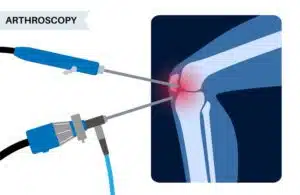Arthroscopic knee surgery is a minimally invasive surgical procedure performed to diagnose and treat knee conditions. The doctor uses a special tool with a small camera to visualize the knee joint and make repairs to restore function and relieve knee pain. If you’re scheduled for arthroscopic knee surgery, your orthopedic care team can help you prepare…
Arthroscopic Knee Surgery
How Does Arthroscopic Knee Surgery Work?
Arthroscopic knee surgery is one of the most commonly performed minimally invasive surgical procedures in the United States. Arthroscopic knee surgery involves the use of adevice, known as an arthroscope, to see the inside of the knee joint and repair the damaged joint. If you have knee pain that is not getting better with conservative…
How to Prepare for Arthroscopic Knee Surgery
Arthroscopic knee surgery involves the use of highly advanced techniques for repairing the inner structures of the knee that have sustained a severe injury. It can be used to diagnose and repair damaged ligaments and cartilage, fix fractures, or remove inflamed synovial tissue. The surgery has a high success rate in achieving the goals of…
How to Choose the Right Arthroscopic Knee Surgery Procedure
Knee arthroscopy is a minimally invasive procedure to diagnose and treat a wide range of knee conditions and injuries. Thousands of people in the United States undergo this procedure every year to alleviate knee pain, reduce inflammation, and increase knee mobility. However, with so many knee arthroscopic surgery options available, it can be challenging to…
When Is Arthroscopic Knee Surgery Recommended?
Knee injuries and conditions cause a great deal of pain. Knee pain, accompanied by knee stiffness and loss of mobility, can make even simple activities challenging. While most of the time, knee pain gets better with conservative measures, other times when knee pain fails to improve the conservative measures, knee arthroscopy is recommended. Let’s learn…
How Does Arthroscopic Knee Surgery Work?
Arthroscopy is a surgical procedure in which your surgeon makes a small incision and inserts a tube-like device with a tiny camera attached to one end (called an arthroscope). Arthroscopes allow orthopedic surgeons to view the inside of the joint on the screen and eliminate the joint problem using tiny instruments.Additionally, orthopedic surgeons may also…
Benefits of Knee Surgery
Even though scary, knee surgery can provide you with relief from a myriad of symptoms that interfere with your daily routine tasks and for which nonsurgical treatments are not enough. Many things can warrant knee surgery, including osteoarthritis of the knees, gradual wear and tear of the knee joint, knee disease, and trauma to the…
What You Need to Know About Arthroscopic Knee Surgery
Not long ago, people used to be afraid of getting under the knife, primarily because of the large incisions made during open surgery. Thanks to the advancement in technology, it’s now possible to have a surgical procedure done by making tiny incisions of one to two inches. This is named arthroscopy – a minimally invasive…
5 Tips For Arthroscopic Knee Surgery
Arthroscopic knee surgery is a minimally invasive surgical procedure used to diagnose and treat problems with the knee joint. The most common reason for arthroscopic knee surgery is to repair a torn meniscus, but it can also be used to treat other conditions such as arthritis or ligament damage. Here are 5 tips for successful…
7 Common Injuries That Arthroscopic Knee Surgery Can Help With
Arthroscopic knee surgery is a minimally invasive procedure used to treat a variety of issues within the knee joint. The knee joint is composed of bone, soft tissue, and cartilage, and any one of these can develop problems. Traditionally, knee surgeries were performed as open surgeries, where large incisions had to be made, the pain…











